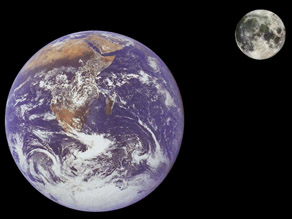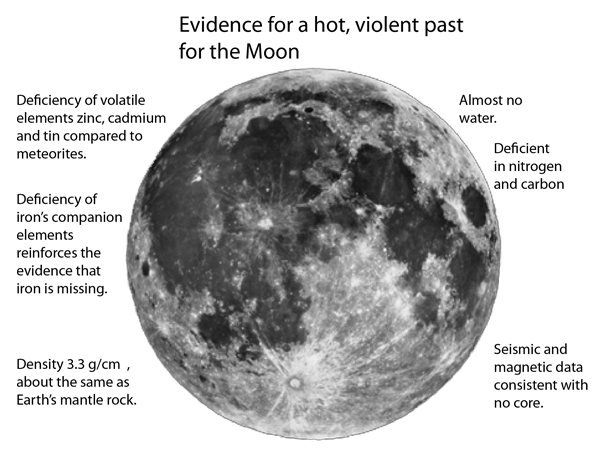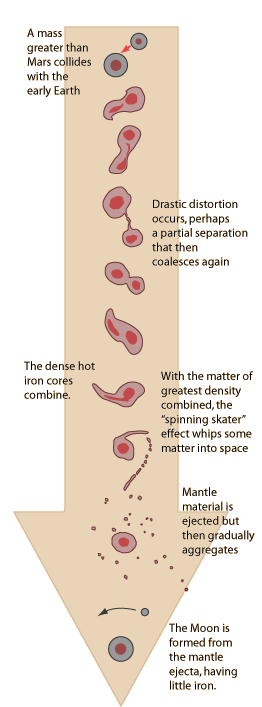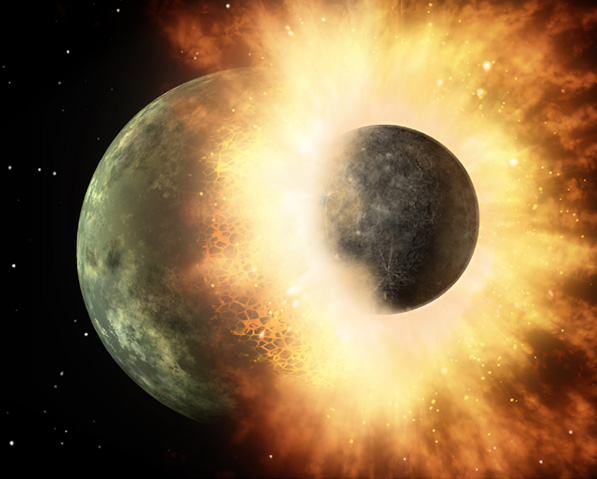The Formation of the Moon
The compositions of the four inner "rocky" planets are similar with Mercury at density 5.4 g/cm3, Venus at 5.2, Earth at 5.5 and Mars at 3.9 g/cm3. This is interpreted as evidence of a core of iron and nickel, with Mars having a smaller core. Even the largest meteorites often show iron/nickel cores, so that the iron core seems like a signature for the formation of massive objects in the inner part of the solar system.
 | But Earth's Moon with a density of 3.3 g/cm3 is very different from the Earth and from the other bodies in the inner solar system. This was one of the first clues that the origin of the Moon was not just accretion from the same material from which the Earth was formed. |
Using data on the structure of the Earth, a simplified perspective can be constructed of the inner planets and Earth's Moon. The size of Earth's core is shown, and the planet densities above are used to construct similar images of the other inner planets. All except the Moon have sizable iron cores. The moons of Mars are too small to show in this perspective.

By the time the Moon samples and extensive data from the Apollo program were analyzed, it was clear that the Moon had a hot, violent origin which left it without significant iron content. The process of modeling the process could begin.

According to Ward and Brownlee, there is remarkable similarity between the trace element content of the Moon rocks and rocks from Earth's mantle. Also the isotopic content of the Earth and Moon samples was essentially identical.
More than a decade was spent analyzing the rich body of information from the Apollo program, including many detailed studies of the surface rocks collected from the Moon. By the mid 1980's there were a number of advocates for an extraordinary and seemingly unlikely scenario for the formation of the Moon. The proposed formation process involves a collision of the young Earth with a body with the mass of Mars or greater. At right is a series of sketches which qualitatively describe this scenario. These sketches follow Ward and Brownlee, who credit A. Cameron and R. M. Canup with computer simulations of this series of events. In view of the facts that the tilt angle of the Earth's spin axis is favorable to life, and that the mass of the large Moon is important in stabilizing that spin axis, this proposal for the Moon's formation is remarkable indeed. "To produce such a massive moon, the impacting body had to be the right size, it had to impact the right point on Earth, and the impact had to have occurred at just the right time in the Earth's growth process."(Ward & Brownlee)
|  |
This hypothesis about the origin of the Moon is sometimes called "The Big Whack"
According to Canup's simulations, most of the above series of steps would have been acomplished in a time period on the order of a day! She also projects that the Moon might have then formed from the debris in a period on the order of a hundred years. Since rock samples from the Moon have been dated as old as 4.4 billion years, the projected impact is placed in the first 100 million years or so of the Earth's formation.

This is an artist's conception of the mooon-forming impact from NASA, image credit NASA/JPL-Caltech. There is an accompanying video at the linked NASA site.
| Alternative hypotheses for Moon formation |
Habitable planet concepts
Ward & Brownlee
Ch 10
Cameron & Canup
| HyperPhysics***** Astrophysics | R Nave |